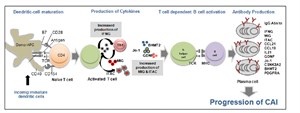Integrative Approaches to Understanding Chronic Allograft Injury
 Chronic allograft injury (CAI) is a poorly understood process of accelerated histological injury in the allograft that results in accelerated functional decline and is the major cause of transplanted kidney loss. We have taken an innovative 3 pronged integrated analysis on serial matched biopsy, urine, and serum samples incorporating biopsy microarrays, urinary proteomics and serum protein-arrays collected from the same kidney transplant patients to discover, validate and predict CAI, before irreversible damage occurs, and eventually replace the invasive renal biopsy. Chronic Allograft Injury (CAI) is best considered as a non-specific end-pathway of tubulointerstitial, microvascular and glomerular damage that results from the variety of insults to the transplanted kidney.
Chronic allograft injury (CAI) is a poorly understood process of accelerated histological injury in the allograft that results in accelerated functional decline and is the major cause of transplanted kidney loss. We have taken an innovative 3 pronged integrated analysis on serial matched biopsy, urine, and serum samples incorporating biopsy microarrays, urinary proteomics and serum protein-arrays collected from the same kidney transplant patients to discover, validate and predict CAI, before irreversible damage occurs, and eventually replace the invasive renal biopsy. Chronic Allograft Injury (CAI) is best considered as a non-specific end-pathway of tubulointerstitial, microvascular and glomerular damage that results from the variety of insults to the transplanted kidney.
The resultant fibrotic lesion is a manifestation of the allografts limited healing repertoire in response to this varying injury, and its evolution remains the main clinical barrier to sustained graft survival, despite improvements in immunosuppression and decreased acute graft loss. The use of protocol biopsies in long-term monitoring studies has found that allograft damage is common across all renal transplants. This damage is time-dependent, progressive and underestimated by the measurement (rise) of serum creatinine alone. CAI has many immune and non-immune causes that have been implicated, which include acute rejection, subclinical rejection, calcineurin inhibitor nephrotoxicity, ischemia/reperfusion injury and pre-existing donor disease.
The corresponding molecular pathways leading to allograft injury are less well defined and are limited to a few studies. These cross-sectional (clinically indicated samples) or surveillance biopsy studies have demonstrated fibrogenic gene expression, although when derived from end-stage grafts, the information becomes less clinically useful in a chronic setting. None have focused on the early post-transplant period. There have also not been any analysis of corresponding biopsy, urine and blood samples by different approaches, in the same patient, which can significantly enhance the discovery process for critically regulated pathways in CAI.
Our research has focused to fill these gaps in the understanding of CAI, by using an integrative comprehensive analysis of the allograft and recipient transcriptome (biopsy, urine and serum) matched with clinical data on protocol biopsies; beginning early post-transplant right through to 2 years post-transplant. We will use this new understanding to develop clinically relevant non-invasive biomarkers of CAI that can enhance patient monitoring for customized management and graft surveillance.